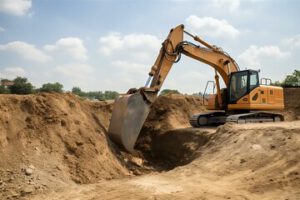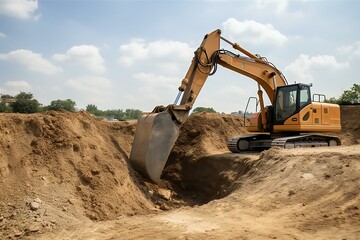Leveling your ground is an important step before constructing any building. Level Ground Excavation helps to ensure proper drainage and prevents structural damage. It also allows properly positioning of pipes, cables, and other underground services.
 A good grading contractor can help you with this by creating slopes that are the right height for your project. They may use benching if the slope angle or soil type prevents sloping.
A good grading contractor can help you with this by creating slopes that are the right height for your project. They may use benching if the slope angle or soil type prevents sloping.
Excavator
An excavator is a large construction machine used to dig holes for a variety of purposes. It can be purchased or rented for projects like digging swimming pools, backfilling to cover trenches, or preparing construction sites. Its arms are affixed with different types of attachments to perform specific tasks, such as shears for demolition, augers for drilling holes, rippers, and dredge pumps. Excavators are available on wheels or tracks and are able to maneuver over rough terrain.
When grading excavation work is being done for a new home, it is important to ensure that the foundation is solidly supported on a firm soil base. This helps prevent damage from water or uneven settling in the future. Excavation experts can create slopes and contours that help direct water away from the building site, which also helps to protect it from potential water damage and erosion issues.
Because leveling excavation involves working with heavy machinery and excavating dirt, it is often a job that requires a permit from the city or county. A professional excavation company will know if permits are needed and can help the homeowner with the process. Because this type of work can disturb pipes and other underground utilities, it is very important that all proper precautions are taken by the contractor. This is to ensure the safety of workers and avoid costly damages to property. For example, the area should be cleared of any existing structures or trees.
Bulldozer
A bulldozer is a powerful piece of equipment that can be used for leveling ground. It is an essential tool for construction, farming, demolition and wrecking jobs. A bulldozer consists of a tractor-like body with a metal plate blade at the front. It also has a back-mounted device called a ripper that functions like a claw to loosen densely packed materials. Bulldozers are large and heavy machines, and they operate on tracks instead of wheels to allow them to maneuver in difficult terrain.
A dozer’s tracks are wide, and they spread out the machine’s weight across a large area to decrease its ground pressure. They are also designed to provide good traction on uneven terrain. Bulldozers are available in a variety of sizes to accommodate different types of projects and terrain.
Before construction can begin on a building or a road, the land must be cleared and leveled. Bulldozers are able to clear away trees, bushes, and other natural vegetation quickly and efficiently. They can also remove scrap and garbage from the site.
Once the bulldozer has leveled the ground, it is important to remove any stones or roots that are obstructing the surface. This is often a time-consuming task that requires the use of a shovel, but it is crucial for creating a proper level surface. Once this step is complete, the soil can be fed with compost or other material that will help it to become healthy and fertile for growing crops or covering roads.
Bobcat
The Bobcat is a versatile piece of machinery that can scoop and move dirt and then use different attachments to flatten and smooth out new surfaces. It’s often used on construction sites but can also be useful for home improvement projects like leveling the ground.
One of the best ways to get professional results without spending a fortune is to rent a bobcat. These machines are highly efficient and have advanced safety mechanisms that make them safer to operate than older models. Moreover, they allow homeowners to take on multiple tasks at once and save time and money on labor costs.
There are many different attachments that can be used with a Bobcat to achieve the desired result, such as the grading blade which is perfect for leveling the ground. Additionally, homeowners can use a trencher attachment to dig holes for fence posts or even a forestry cutter to clear overgrown trees and brush.
The first step in achieving the ideal grade is to mark out the area you’re going to cover with gravel using string and stakes. Next, remove the top layer of soil and level it to your desired grade. Lastly, add the gravel and compact it. Be sure to account for the height of the gravel when grading your yard, as you’ll want to avoid overfilling the area. To prevent your bobcat from getting bogged down, start at the front of the bucket and lower it until you reach the desired gradient.
Loosen the Soil
Leveling ground is an important step in many outdoor projects, whether it’s preparing land for landscaping or building a patio or driveway. It is a complex process that requires an expert excavation contractor with years of experience. It’s best to hire a professional company for this work rather than risk ruining the project.
To start, loosen the soil with a spade or shovel. You’ll also need a rake and a level. Once the soil is loose, remove any large stones or roots that may be obstructing the proper leveling of the ground. Once the area is free of obstructions, level the soil with a hard metal rake. Make sure the rake is flat and spread evenly, creating a slight downhill slope for surface water to drain away.
When finished, sprinkle the newly-leveled soil with water 3 to 4 times over 48 hours. This will help the soil settle down and prevent weed growth in the future. Then, compact the soil using a tamper or plate compactor (see above image). Let the tamper or plate compactor do its job until the ground is tight and not moving anymore. Finally, wait a few days for the soil to dry before you walk or put anything on it.
Remove Obstructions
Whether you’re preparing to construct a foundation, installing a pool or pouring concrete for sidewalks or patios, level ground excavation is essential to the success of your project. The process involves digging holes and trenches in the soil with heavy machinery like excavators and backhoes.
Before excavating the site, contractors clear obstructions like trees, stumps, vegetation and other debris from the area to prevent them from interfering with work later. This is a key step because if these materials are left in place, they could become stuck inside of the equipment or get in the way of the work being done.
In addition to clearing obstructions, contractors will also prepare the site by clearing and grubbing the area of any roots, rocks or other material that may be encountered during excavation. This helps protect the contractor from accidentally digging up underground utility lines or other things that could cause serious problems down the road.
Once the site has been prepared, contractors will install the desired grade. They will level the topsoil using a hard metal rake and a smooth finish. They will also ensure that there is a slight slope in the topsoil so that surface water can drain away from the construction site. If topsoil is being amended with compost, the Contractor will thoroughly blend compost with on-site topsoil at a rate specified in the contract documents.
Feed the Soil
A good leveling excavation needs to be done before the construction starts. This process allows the builders to work on flat land instead of on sloped areas that could eventually become damaged by water. It’s important to get this job right because it will protect your investment from unnecessary damage that could arise due to drainage problems.
The soil must be able to hold the structure you plan on building and drain away excess moisture. It’s a good idea to hire a professional that has experience working on various projects with different types of soils. Some areas have granular soils that are easy to excavate and build on, while other soils require special care because they tend to be more prone to erosion.
After raking and tamping the soil, it’s important to give it time to settle. It may take several days or even weeks for it to be completely settled and ready for construction. It’s a good idea to mist the area 3 or 4 times during this period to keep it moist.
It’s also important to check the ground often. Any parts that have dropped below the leveling line should be raked and tamped up again. Repeat the process as needed until you reach your desired grade. It’s a good idea to use a hard metal rake to create a smooth surface. This will ensure the final grade is consistent and aesthetically pleasing.
